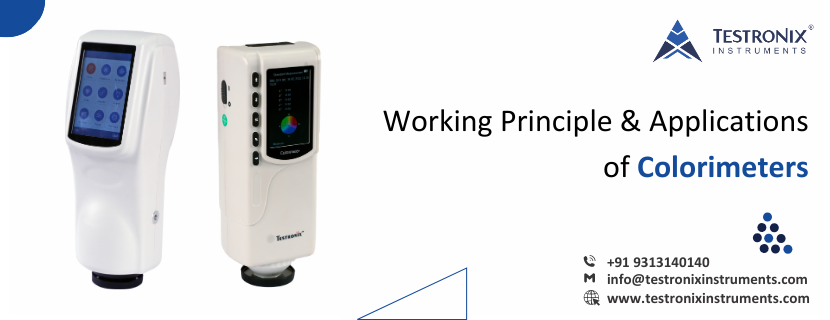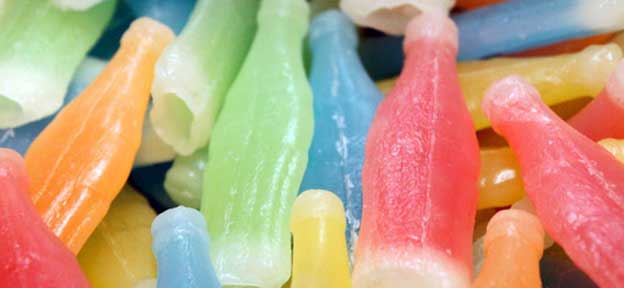When it comes to the appearance of products, the most important aspect of appearance is the color of the product. The color contributes a major portion of the appearance and hence it is essential to ensure that the color of the products is of the best quality and level. To ensure that the color of the products is of the best quality and level, a colorimeter is used. The colorimeter is a device that is mainly used in industries and laboratories for analyzing the color quality of the products along with color measurement.
What is Colorimeter?
The colorimeters are highly sensitive devices that can measure the concentration and intensity of a particular color that is used in a product. There are mainly two different types of colorimeters that are used in industries the TP 110 portable colorimeter and the Spectrophotometer TP 800.

The color densitometers measure the color density of primary colors in a color combination in a test sample. The color photometers are used for measuring the reflectance of a color as well as the transmission.
What is digital colorimeter?
A digital colorimeter is an advanced version of the typical colorimeter that uses digital technology to provide precise readings. It calculates absorbance or transmittance digitally and displays the results on a readable screen.
Digital colorimeters have features like memory storage for past measurements, data transfer options, and greater accuracy. Digital colorimeters are used in industries where accuracy and simple data handling are crucial, such as quality control, scientific research, and manufacturing.
Testronix is a leading colorimeter manufacturer in India and designs different quality colorimeters at the best and most affordable prices. Our Colorimeter has been designed as per industrial standards that make it easy for the manufacturers to conduct colour measurement tests on different materials accurately.
Testronix is a leading colourimeter manufacturer in India and designs different quality colourimeters at the best and most affordable prices. Our Colorimeter has been designed as per industrial standards that make it easy for the manufacturers to conduct colour measurement tests on different materials accurately.
With Testronix colourimeter, manufacturers can easily ensure accurate and reliable test results.
Colorimeter Diagram
The necessary parts of the colorimeter diagram include: a light source, an aperture, a filter, a photocell or tube, a detector, and a cuvette (a glass tube). Here is an explanation of these components that are discussed below:
Light source
The light source in a colorimeter offers a stable beam of specific wavelengths, allowing precise measurement of absorbance to determine the concentration of a substance.
An Aperture
The aperture in the colorimeter regulates and guides the flow of light guaranteeing accurate measurement by reducing unwanted or excess light.
Filter
In colorimeter the filter selects a particular wavelength of light, guaranteeing only a specific wavelength passes through the sample for precise measurement of light absorption.
Photocell
It senses transmitted light intensity, converting it into an electrical signal to measure optical density and solution strength.
Cuvette
A cuvette in colorimeter contains the sample solution, allowing light to pass through for measurement. It maintains a consistent path to ensure precise absorbance measurements.
How Does Colorimeter Work
A colorimeter determines the light absorbance at a given set of wavelengths from a colored solution. It consists of a light source that sends light through a filter that isolates the wavelength corresponding to the maximum absorbance of the analyzed compound. The light passes through a cuvette containing the sample, where the colored substance absorbs a portion of the light.
The rest of the light travels to a detector that translates the light intensity into an electrical signal. The intensity of the light sent is compared against a calibration curve, and using this, one can calculate the concentration of the colored compound using its absorbance. Here are the steps involved in colorimeter working -
Step 1: Switch the device on by turning the Power Switch knob to the right. Allow 15 minutes for the colorometer to warm up and stabilize.
Step 2: Once the warm-up is complete, adjust the wavelength Control knob to the desired wavelength.
Step 3: Press the Mode control key until the Transmittance light turns on to set the display to transmittance mode.
Step 4: Turn the Zero control knob to adjust the T-Factor to 0.0%, making sure the sample chamber is empty and the cover is fully closed.
Step 5: Fill the cuvette with the blank solution up to the top of the solution of the triangle marketing. Wipe the cuvette’s exterior with a Kimwipe to remove any liquid or fingerprints, as they can interfere with light transmission and cause incorrect measurements.
Step 6: Gently place the tube into the cuvette chamber with the vertical guideline facing right. Rotate the cuvette 90 Degrees clockwise to meet the guidelines.
Step 7: Adjust the transmission control knob under the display shows 100.0%.
Step 8: Press the mode key to switch the status indicator light to absorbance.
If the transmission was calibrated correctly the display should read 0.0. If not adjust it using the transmittance knob. Then press the mode key again to return to transmission mode.
Step 9: Carefully remove the cuvette by reversing the insertion process, then close the compartment cover.
Colorimeter Working Principle
A colorimeter follows the principle of Beer-Lambert Law, which states that light absorption by a solution increases with the concentration of the absorbing substance and the path length of the light. According to this law, a more concentrated solution absorbs more light.
It measures how much light a solution absorbs at a specific wavelength. It then utilizes this absorbance to determine the concentration of the substance in the solution.

Formula of colorimeter:
A = εcl:
Where,
A: is the absorbance of the solution
ε(epsilon): is molar absorptivity
c: is the concentration of the solution
l: is the distance traveled by light in solution
A specific wavelength of light passes through the sample solution, and its absorption is measured against a specific standard. Higher absorbance correlates with higher concentration, while lower absorbance indicates lower concentration. This technique provides accurate quantification of substances in a solution.
How Colors can be analyzed using Colorimeters?
To analyze the concentration of an unknown sample, there are several specimen prepared from the test sample and then tested using an efficient colorimeter. After analysis, the transmittance and concentration of the tested specimen are plotted on a graph to obtain a graphical representation of the concentration creating a calibration curve.
This curve is then compared with the curve of a known sample, and the concentration is measured. Testronix colour measurement instruments help in accurate colour analysis.
What are the Different Types of Colorimeters?
There are three major types of colorimeters based on: size, filters, and display. Here is a brief explanation of each type of colorimeter in detail -
Based on Size
a) Benchtop colorimeter: It is slightly larger and requires a benchtop for operation. It operates within a wavelength range of 420-660 nm, providing high accuracy while using only 1.5 ml reagent making it ideal for laboratory compound analysis.
b) Portable colorimeter: This compact device is portable and can be used outside the laboratory. It is beneficial for food and water analyses in outdoor settings, with a typical wavelength range of 420-660 nm offered by manufacturers.
Based on Filters
a) Tristimulus colorimeters: This type of colorimeter uses three filters to detect the intensity of primary colors: red, green, and blue (RGB). It is the most commonly used filter in colorimeter.
b) Densitometer colorimeters: They use a single filter to measure the intensity of a specific light color and help evaluate bacterial and yeast growth density.
c) Spectrophotometer colorimeters: A spectrophotometer colorimeter measures light absorbance at different wavelengths using a prism. It ensures accurate chemical analyses, making it useful for pharmaceutical, biochemical, and environmental research.
Based on Display
Analog colorimeter: The analog colorimeter display features a scale, where the top numbers indicate transmittance and the bottom numbers show absorbance. The movement of the arrowhead indicates variations in absorbance and transmittance.
Digital colorimeter: It is displayed on an LED screen. Digital colorimeters rapidly replacing analog colorimeters.
How to use colorimeter?
A colorimeter is an instrument that is used to measure the intensity of specific colors in a solution by determining the amount of light absorbed or transmitted at specific wavelengths.
Here’s how you can use a colorimeter:
- Preparation: set up the colorimeter before use, if needed, using a known color standard. Clean the surface to be measured to avoid interference.
- Positioning: Place the colorimeter flat and perpendicular to the surface you want to measure.
- Measurement: Activate the device and press the measurement button. The colorimeter captures the reflected light and calculates the color values (like CIE Lab, RGB, or CMYK).
- Analyze: Read the results on the display or software to compare them to your desired color standard.
- Recording: Save or note down the measurements for future reference, especially in quality control.
- Cleaning: Clean the colorimeter with a soft cloth after use.
What is the difference between a colorimeter and a spectrophotometer?
A colorimeter is an instrument used to measure color by capturing light at specific wavelengths through filters that capture the red, green, and blue (RGB) components. While a spectrophotometer measures color by capturing all wavelengths of light across a broad spectrum. Here are the major differences between a colorimeter and a spectrometer:
-
Colorimeters measure color using RGB filters, while spectrophotometers measure all wavelengths of light.
-
Spectrophotometers offer greater precision in detecting subtle color differences.
-
Colorimeters are used for visual color matching, while spectrophotometers are used in scientific, manufacturing, and photographic applications.
-
Colorimeters are more affordable, while spectrophotometers are more expensive.
-
Colorimeters are often more portable, whereas spectrophotometers are bulkier and require more setup.
Colorimeter Vs Spectrophotometer: Difference Explained
| Features | Colorimeter | Spectrophotometer |
| Principle | Measures absorbance of light at specific wavelengths using filters | Measures absorbance across a wide range of wavelengths using prisms or diffraction gratings |
| Light Source | Uses LED or tungsten lamps | Uses a broader light source, including UV, visible, or infrared light |
| Wavelength Range | Limited to the visible spectrum (400-700 nm) | Covers UV, visible, and infrared regions (190-1100 nm) |
| Cost | More affordable and easy to use | More expensive due to advanced technology |
Applications of Colorimeters
Colourimeters have diverse applications across various industries, proving to be invaluable laboratory testing instruments for precise colour measurement and analysis. In quality control, colourimeters are frequently employed to ensure consistent colour in manufactured products, such as textiles, paints, and plastics.
Additionally, colourimeters are utilized in scientific research, particularly in fields like chemistry and biology, where accurate colour analysis is essential. Their versatility extends to clinical applications, where colourimeters are employed in medical diagnostics, such as blood testing and urine analysis. You can also read more on the importance of colour measurement in different industries.
Testronix’s colourimeters can be used for measuring the carol concentration and intensity of a variety of materials such as:
- Food ingredients,
- Building materials,
- Textile products,
- Beverages,
- Chemical solutions and many others.
The Testronix colorimeters offer high accuracy of test finding along with a high rate of repeatability which allows the manufacturers to ensure the best color quality and appearance of their products.
If you want to test the color accuracy of the product with the help of Testronix color measurement testing instruments then you can give us a call at +91 9313 140 140 or email us at info@testronixinstruments.com. Our team of technical experts will consult you regarding all your needs and queries.





